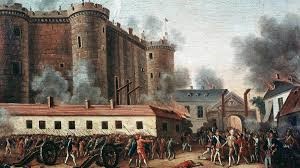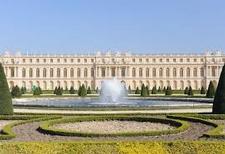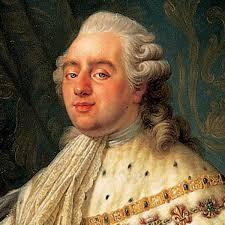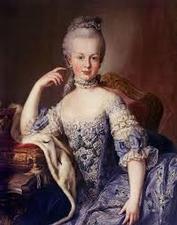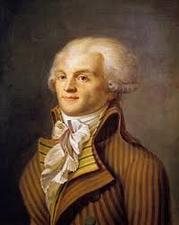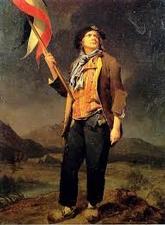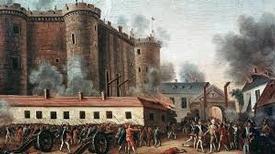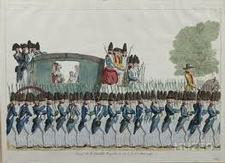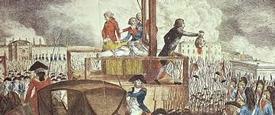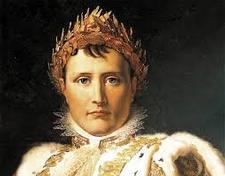On 16th May 1770, France’s elite took shelter from a thunderstorm as they gathered to celebrate a momentous occasion. The heir to the throne, Louis, was marrying an Austrian princess, Marie Antoinette. The celebrations took place in the palace at Versailles, the most spectacular in all of Europe. As royalty and aristocrats indulged themselves at the fabulous party, it must have seemed that their power would never wane and that France’s place as the global centre of culture and extravagance would never be lost.
But the storm that raged that night was an omen for the disaster that was to befall France’s elite. The Prince and his bride would be dead within 23 years, executed as traitors to their country, and the wealthy guests at their wedding would either follow them to the guillotine or be forced to flee for their lives. They would be swallowed by a movement that was inspired in large part by their extravagance and refusal to countenance any meaningful change.
The Palace at Versailles was a far cry from the widespread poverty in France
12 miles to the east of Versailles lay the city of Paris, burgeoning with desperately poor inhabitants as well as a booming middle class who were becoming fed up with the political and economic oppression they faced. The city reflected the nation as a whole – a nation where poverty was rife, where the vast majority of the population were afforded no political power and were forced to pay crippling taxes to finance the ruling classes. This was a system that had lasted for centuries, but at the end of the 18th century a perfect storm of events would culminate in the system collapsing. Burdened by poor harvests and desperate for food, the French peasantry and working classes exploded in anger at the same time as the French middle classes, inspired by the ideas of the enlightenment, were asking why they should accept the inadequate status quo. The result was several turbulent years of hope, inspiration and bloodshed. The result was the French Revolution.
The Ancien Regime
Before the revolution, the structure of French society was called the Ancien Regime, which translates as the old or ancient regime. It was a society split into three distinct classes, or estates, the first of which was the Catholic church and its clergy. The second estate was made up of the royalty and nobility, and the third estate was literally everyone else. That meant that you could be educated and have a successful trade but if you weren’t royal, noble or a member of the clergy then you remained firmly pinned down in the third estate. The estates could be subdivided – particularly the third estate, which was so vast it included anyone from peasants to labourers to bourgeoise professionals – but they remained distinct from each other.
The system was grossly unfair, with the top two estates being exempt from most taxes despite the fact that they owned by far the most land and wealth. The third estate were therefore forced to pay disproportionate taxes while also having virtually no political power. To the modern mind this was a clear recipe for disaster, but in 18th century France it was just the way things were. There were occasional calls for reform from within the top two estates, but they were drowned out by their peers who either opposed any challenges to their power or were just indifferent to the plight of the third estate. By the 1780s, the top two estates made up just 2% of the entire population, and the tinder for the 98% to rebel was being steadily laid.
The road to revolution
A decade before the royal wedding at Versailles, King Louis XV had gambled on fighting Britain in the seven years’ war (1756-1763) and lost. The venture decimated French finances as the treasury was ruined by war debt and the loss of income from lands ceded to the British. On 10th May 1774, Louis XV died an unpopular King, leaving behind a nation on the brink of bankruptcy. In his place came his grandson, the man who had married Marie Antoinette, who was crowned Louis XVI. That summer, the new King and Queen travelled to a prestigious college in Paris where they were greeted by a young law student who read a passage to them in Latin. The royal couple made no attempt to appear interested in what the student was saying, but if they could have known the man that he would become they may have paid more attention to him. His name was Maximilien Robespierre, and this was not the last time their paths would cross.
In truth, Louis was never cut out to be King. Shy and painfully indecisive, he was fearful as he came to the throne and regularly prayed for help in the first months of his reign. He possessed no social graces, he was not physically attractive – Louis XV’s mistress labelled him a ‘fat, ill-bred boy’ – and he was always likely to be persuaded on a matter by the last person he spoke to. In contrast, his wife Marie had wide blue eyes surrounded by a pretty face and enjoyed the decadent parties at Versailles. The two could not have been more different in personality and did not have a child for eight years. This sparked grossly unfair rumours that Louis was not interested in Marie – perhaps he was even homosexual – and that Marie was carrying on extra-marital affairs with courtiers. In fact, Louis suffered from a physical condition that made it painful for him to have sex. The condition was corrected by a simple procedure, and sure enough Marie became pregnant soon after. However, the unfair rumours that had spread about the royal couple had planted a seed in the head of the French people that Louis was impotent and Marie was promiscuous. They had finally developed some chemistry in their marriage by 1778, but what united them both was a firm belief that they were chosen by God to rule their people and that to shy away from the task would be a dereliction of duty. This parental attitude towards the French people was to inform a lot of the disastrous choices they made before and during the revolution.
Marie Antoinette earned the nickname 'Madame Deficit'
Perhaps in an attempt to prove to his people, or to himself, that he fit the role of a macho King, Louis provided military help to the Americans during their revolutionary war against Britain (1775-1783). The Americans won the war and Louis could be satisfied that he had avenged his grandfather’s defeat to the British 20 years previously, but the campaign had ruined French finances even further. The finance minister during the war, a popular man named Jacques Necker, had implemented some modest reforms but had not been able to persuade the top two estates to sanction extra taxation to fund the war effort, so was forced to borrow the money. By the end of the war, the King had spent enough money to feed and house 7 million of his subjects for a year, and his kingdom was crippled by debt.
France’s finances were not helped by Marie Antoinette’s penchant for fine clothes and dazzling parties. Life at Versailles was a never-ending cycle of expensive routines and spectacles, and the Queen was draining the treasury further by her increasingly costly fashion choices. With the country in the grip of economic crisis, she earnt the nickname ‘Madame Deficit.’
Louis’ foray into the American revolutionary war also meant that French soldiers were returning to their homeland with dangerous revolutionary ideas. Having been exposed to the American ideals of equality and liberty, they were beginning to question the oppressive political system in France. There was already fertile ground for these ideas in France due to the period of enlightenment, where writers such as Voltaire emphasised the value of individual freedoms and challenged the concept of monarchy and the authority of the church. For the first time, French people were rejecting the idea that monarchy and aristocracy was natural. Strangely enough, these enlightenment ideas were most popular among aristocrats, who gathered in elite bars and cafes across France to discuss them, but they were also wildly popular in the third estate, particularly among the professional class. These people were waiting patiently for the chance to put their progressive ideas into action.
After other finance ministers were unsuccessful in trying to turn the French economy around, Necker was re-appointed in 1788 and almost immediately called for a meeting of the Estates-General, a body made up of representatives from all three estates that had not been summoned since 1614. In calling the meeting, Necker hoped to pressure the nobility into sacrificing some of their tax immunities in order to save the French economy. He would end up getting far more than he bargained for.
The Tennis Court Oath
Necker was more astute than most nobles in sensing the need for reform, but he had misjudged the desperation of the third estate. In 1788 a series of thunderstorms had devastated crops in France and ruined that year’s harvest. With the people starving, meagre concessions were not going to be good enough to satisfy them.
The meeting was scheduled for 5th May 1789, and in the meantime members of each estate in each region of France were asked to select leaders to represent them and compile a list of grievances to present to the King. While the clergy and nobility did accept the need for fiscal reform and even showed signs of supporting a more representative government, too many nobles refused to give up the privileges they enjoyed under the current system – not least their tax exemptions. The clergy were likely to side with them on the matter, giving them a voting advantage over the third estate despite the fact they represented such a small portion of the population. The injustice was not lost on the third estate delegates, who demanded that delegates in the estates general be more fairly proportioned. The debates over the grievances and procedures were very public and made the meeting highly contentious before it had even convened.
One of the third estate delegates from the region of Arras, in northern France, was none other than Maximilien Robespierre. After graduating from college in Paris, where he had greeted the King and Queen 15 years previously, he had opened a law practise in his hometown and continued to read widely, absorbing the ideas of the enlightenment. He could be an alienating character to those around him – his focus on his clothes and physical appearance made him come across as vain and his faith in his ideas sometimes bordered on being obnoxiously self-righteous – but he had come to see himself as a voice for the downtrodden and had phenomenal oratorial skills. He led an increasingly radical faction in the estates general who demanded that the top two estates pay their fair share in taxes.
Maximilien Robespierre
After a contentious six weeks during which nothing had been agreed, the nobility was becoming impatient with the third estate. They convinced King Louis, who was easily persuaded at the best of times and already offended by what he saw as challenges to his divine right to rule, to deny the third estate entry to any more of the meetings. On the morning of 20th June, third estate delegates arrived in Versailles to find that they were no longer welcome at the meeting. In response, they gathered at a nearby indoor tennis court and made a solemn vow that they would not return to their home regions until they had won concessions from the King and nobility, including a new constitution. They declared themselves the national assembly, the true representatives of the French people.
Within a week, most of the clergy had joined them, along with 47 liberal nobles. On 27th June, King Louis reluctantly disbanded the estates general and formally created a national assembly, where representatives from the three estates were fairly proportioned. The assembly started work on a constitution.
The storming of the Bastille
A member of the Sans-Culottes, wearing common trousers rather than breeches, holds a revolutionary tricolour
The new assembly was still working on a constitution in mid-July when residents in Paris started spotting royal troops gathering outside the city. Louis had mustered an army of 30,000 soldiers to attempt to reverse the small concessions he had made. Louis then made a further unpopular move by sacking Jacques Necker. The people held him in high esteem for organising the estates general in the first place and facilitating the creation of the new assembly, but this was the exact reason that the royal court held him responsible for the revolt of the third estate. Fearful they were about to lose what they had only just gained, Parisians rushed to defend themselves and created a national guard made up of any man – and some women – physically capable of fighting. Most of the mob were sans-culottes (without breeches), a reference to their lack of the fancy breeches favoured by France’s elite, and many of them wore rosettes made of blue and red, the traditional colours of Paris, separated by white, the colour of the royal family. The French tricolour was born. The makeshift soldiers were armed with over 25,000 muskets and other weapons stolen from the military hospital in the city, Les Invalides. All they needed now was gunpowder, and there was only one place to get it.
The Bastille was an intimidating structure near the centre of Paris used for military storage and as a prison. With walls that stood at 30 meters tall, the gothic 14th century building dominated the city’s skyline and had a notorious reputation as a place where enemies of the crown went in and were never seen again. It was a symbol of the awesome, tyrannical power of the French state and struck fear into the hearts of ordinary people. But that fear was replaced by visceral anger on the muggy afternoon of 14th July 1789. With the threat of an occupation by royal troops looming, the feverish Parisian crowds marched to Bastille and demanded that the governor, the Marquis de Launay, hand over the gunpowder reserves to them. Confident that the walls of the fortress could never be breached, the governor refused, but before long the crowds had spilled into the Bastille’s outer courtyards and were fighting with the guards. The skeleton force in the fort were overwhelmed and the governor surrendered, but it was too late to save his skin. Dragged screaming and kicking into the mob, he was effectively lynched and his severed head placed on a pike to the delight of the crowds. Before nightfall, several of his guards and even the Mayor of Paris had suffered a similar fate.
The people of Paris tear the Bastille apart
While the people got to work on tearing the Bastille down brick by brick, King Louis returned from a hunting trip and settled in his quarters at Versailles to write in his diary. His entry for 14th July simply states ‘nothing’ – a reference to his unsuccessful day of hunting. He was stopped from writing anything more by an aide who burst in the room with news of the events in Paris.
‘Is it a rebellion?’ the King asked. ‘No, sire,’ came the reply. ‘It is a revolution.’
Declaration of the Rights of Man and of the Citizen
On 4th August, the national assembly adopted the declaration of the rights of man and of the citizen, a set of democratic principles that enshrined enlightenment ideals and committed the assembly to producing a constitution that focused on individual liberties, such as freedom of speech, and providing economic opportunities for all. Even in the wake of the American declaration of independence 13 years previously, this was an unimaginably radical move and shows how promising and progressive the revolution was at the start. France genuinely appeared to be on the brink of a creating a fair, humane society. For context, at this time the other major European powers were still run by autocratic rulers, apart from Britain, which so often congratulated itself for having a more representative government but had never countenanced such radical reform as seen in France – indeed, it had gone to war in America to prevent such reform.
However, the idealism of the summer of 1789 quickly soured as the realities of politics kicked in. For months the different factions in the assembly argued over their different aims, and all the while the economic crisis had not gone away. As long as the new authorities could not agree on a path forward and the economy was on its knees, there was always a chance that the revolution could be countered.
‘Let them eat Cake’
Although a formal constitution had not yet been adopted, the strict restrictions on press freedoms had been lifted and Paris was rife with revolutionary writings. Chief among them was a daily newspaper, L’Ami du Peuple (The friend of the people), headed by Jean-Paul Marat. A failure in every career he had tried before the revolution, Marat was a bitter man whose refusal to recognise his personal failings was complemented by a paranoid and self-pitying belief that the world was against him. Condemned to a medicinal bath for most of the day as a result of a skin disease he had contracted while living in a sewer, Marat finally found his calling as a professional agitator, alleging that there were plots against the revolution everywhere.
As with most successful media campaigns, there was a degree of truth in Marat’s accusations. King Louis was again gathering his forces around Paris and was rumoured to have hosted a lavish party in Versailles where the new tricolour flag, a symbol of the revolution, was burned. Marat printed the rumours in sensational style on the 2nd October, demanding that the people of France ‘once again wake up!’. On the morning of 5th October, church bells rang aggressively across Paris and a large crowd of women gathered to protest at the shortage of bread. Before long, the crowd were marching the 12 miles to Versailles, armed with whatever weapons they could get their hands on.
When word of the approaching mob reached Marie Antoinette, she is famously alleged to have uttered the phrase: ‘let them eat cake.’ Unfortunately for those of us who like such dramatic moments she never actually said this; however, it does accurately capture her dismissive attitude towards the people and their revolution. But by the following afternoon she was taking the mob far more seriously. After camping outside the palace overnight, and with their number growing by the hour, the women demanded that the King and Queen move their headquarters from Versailles to Paris. As usual, Louis was hesitant, and by nightfall the women had waited long enough. They stormed the gates and streamed into the palace, breaking into Marie’s apartments only moments after she had escaped to Louis’ quarters. The mob tore Marie’s luxurious room apart, and the royal family were left cowering in Louis’s room, totally at the mercy of the women of Paris. With no other choice they agreed to travel to the city and made the journey with the now 60,000 strong crowd, who paraded the severed heads of the royal guards before Louis and Marie. Terrified and humbled, the King and Queen did not have a chance to catch a final glimpse of their fabulous palace. They would never see Versailles again.
The King and Queen seal their own fate
For a year and a half, France operated as a constitutional monarchy, where Louis shared power with the national assembly. The most powerful voice in the assembly was Robespierre, who was developing his oratorical flair with forceful speeches in defence of the least powerful members of society. When not at the assembly, Robespierre spent much of his time at the Jacobin club in Paris, where he discussed his ideas and rallied support for them. His supporters were therefore known as the ‘Jacobins’, while Robespierre himself earnt the nickname ‘the incorruptible.’ The more moderate members of the assembly were called the ‘Girondins.’
But Louis was unhappy that he was being forced into signing laws that were steadily chipping away at his power. Through 1791, he began to take seriously the plans of Axel Fersen, a Swede who had been given a position in the French army and developed a devotion to Marie Antoinette. Fersen suggested that royal family could disguise themselves with common clothes, slip out of the Tuileries Palace where they were being held and make a dash for the border with Belgium, which at that time was controlled by Marie’s family, the Austrian Habsburgs. The Austrians, along with several other European nations, had made their opposition to the French revolution well known and would be more than willing to aid the French royal family in an attempt to regain their power.
The Royal family are taken back to Paris under heavy guard
On the night of 20th June 1791, Louis, Marie and their children slipped out of Paris under the cover of darkness. Fersen had originally planned for the family to be transported in two light carriages that could move through the country roads quickly, but Marie insisted the family travel together. It was a fatal mistake. The large carriage had to be carried by six horses and lumbered slowly towards the border; so slowly that the military entourages that Fersen had secretly organised for them were no longer waiting at their meeting points, and word of the family’s escape actually overtook the family themselves. It was well past midnight by the time they reached the town of Varennes, just 30 miles from the border. Stopped at a checkpoint, a former soldier who had once seen Marie at Versailles recognised her and bowed instinctively. His colleagues then compared the face on a bank note to the face of the carriage ‘valet’ and decided that it was indeed King Louis. The men bowed before the royal family, and Louis was confident that the people of the countryside were more loyal to him than to the revolution. But his confidence was misplaced. The family were held until orders arrived from Paris: they were to be taken back to the capital. Humiliated and disgraced, the royal family were escorted by national guardsmen back to Paris, where they were met by stony silence. Any goodwill the people still had for them was completely gone.
The Guillotine
With the royal family effectively imprisoned, Robespierre was the most powerful figure in the land. He announced plans for universal suffrage, agitated for the official abolition of the monarchy and was adamant that France should get rid of the death penalty. Always a faithful disciple of the enlightenment, Robespierre wanted a firm break with France’s medieval past which had seen all sorts of bizarre and gruesome executions take place. However, the abolition of the death penalty was a step too far for most people – not least the influential Marat, still ranting in his newspaper every day about traitors and counter revolutionaries. Instead, a doctor in Paris presented his idea for a machine that would drop a blade from a certain height and sever one’s head instantly. The doctor’s name was Joseph Guillotin.
Guilltoin’s device was christened the ‘guillotine’, and it was an enthusiastically promoted by Marat and his ilk. It was quick, it was efficient, and – so the doctor claimed – it was painless; although none of its victims have ever been able to confirm that claim. Most importantly, it created a degree of equality: beheading had been a punishment reserved for the nobility in France, but now everyone condemned to death would suffer the same swift fate. The endorsement of the guillotine may have had some good intentions, but it also precipitated the revolution’s descent into anarchical violence. Though it was swift and democratic, it was still a large killing machine with a menacing blade that tumbled onto the necks of its victims at ferocious speed. Everyone in authority now felt as though they had a licence to intimidate their rivals or indeed order their executions.
In April 1792, the assembly declared war on Austria and Prussia, where it was believed many French aristocrats had fled to and were plotting against the revolution. Paranoia was gripping Paris, and on 10th August the King and Queen were formally arrested on the grounds of treason. In September, Marat’s newspaper named hundreds of people as suspected counter revolutionaries. The Paris mobs descended on some of these unfortunate souls and sent them to the guillotine after sham trials. The national assembly then converted itself into the National Convention, and formally abolished the monarchy. France was now a republic.
The execution of the King and Queen
In November, it was discovered that Louis and Marie had been in contact with counter-revolutionary forces in Austria – who France was now officially at war with. Put on trial for treason, Louis’ guilt was never in doubt, but his punishment caused much argument. Some argued he be thrown in jail, but Robespierre understood that as long as the King lived, he would be a rallying point for a counter-revolution. Some argued that he should be exiled, but this was an even more foolish suggestion as he would be freely roaming around in a sympathetic country pushing for military invasions of France. Robespierre was not necessarily enthusiastic about executing the King but, ever the rationalist, he concluded that it was the only rational course of action. He threw his considerable influence behind the King’s execution, and the measure passed narrowly in the convention on 20th January 1793. Louis was given the evening to say an emotional goodbye to his weeping wife and children.
The following morning dawned cold and damp. At 8 O’clock, a cavalry contingent arrived to escort the former King and a priest to the place of execution. The journey lasted two hours, as the streets of Paris were lined with people, who stood silent for the most part. Upon arrival at the Place de la Concord, Louis walked bravely across the scaffold to address the crowd and protest his innocence before an officer ordered that drums were played to drown out his voice. His final defeat complete, Louis turned from the crowd, resigned to his fate. The drums stopped, the blade came crashing down, and an awful silence came upon the crowd for a few seconds. The silence was replaced by sporadic cries of ‘Vive la Republique!’ (long live the republic!), and as Louis’ severed head was presented to the crowd the sporadic cries turned into a unified chant.
After his death, Marie Antoinette was separated from her children and thrown in prison. Under constant guard in squalid conditions, she suffered from terrible depression but was shown some kindness by a few of the guards who saw her for what she was – a grieving wife and mother who had lost absolutely everything. She may not have followed her husband to the guillotine, but a haphazard plot to free her in August forced the convention’s hand. She was put on trial for treason on 14th October where she impressed even her most vicious critics with her calm and dignified manner. However, as with her husband, her guilt was never in doubt. Just before 5 O’clock on the morning of 16th October, she was informed that she would be executed later in the day. She did not say a word.
Marie wrote a final letter to her sister-in-law, the old King’s sister, who was taking care of her children. She professed that she was not bothered about her own death and looked forward to being re-united with her husband, but she was filled with sorrow at the thought of leaving her children orphaned. In a final act of cruelty, the guard she gave her letter to ensured that it never reached its intended recipient.
At 12:30 that drizzly autumn afternoon Marie Antoinette climbed onto the scaffold and said her last words – an apology to the executioner, whose foot she had trodden on. She bravely placed herself on the guillotine with no assistance, perhaps in death finally winning some respect from the French people that had always eluded her in life. When her head was held before the crowd the familiar cry was heard loud and clear: ‘Vive la Republique!’.
The Reign of Terror
The revolution was now entering its most violent phase. In between the royal executions, Jean-Paul Marat was swallowed by the violence he had done so much to provoke when he was assassinated by Charlotte Corday on 13th July. Corday had pretended to be a follower of Marat’s seeking his protection, when in fact she was a Girondin supporter and a member of a minor aristocratic family who resented his role in the revolution. She stabbed him as he lay in his medicinal bath and then found herself resting her head on the guillotine four days later.
Robespierre’s Jacobins had seized control of the convention in June 1793 and set about implementing radical measures such as the creation of a new calendar and the abolition of Christianity. In the midst of war against other European powers, the Jacobins saw plots and treachery everywhere and in September unleashed a ten-month killing spree where literally thousands of people were sent to the guillotine. Robespierre, elected President of the convention in June 1794, had gone from being a progressive leader to a vindictive autocrat whose slightest utterance could condemn someone to death. After his election, he suspended the right of a suspect to a fair trial, perfectly encapsulating his tyranny. Much has been written about him, but the most measured analysis of him is that he was not an intrinsically evil man buy rather one who initially meant well but got caught up in the emotion and turbulence of the revolution. His steadfast dedication to his beliefs meant that he ended up seeing people who did not agree with him as traitors, and he no doubt felt justified in ordering their executions, but in doing so he had become everything he professed to despise. In any case, it became increasingly clear that there was only one way for the violence to end: Robespierre had to go.
On 27th July, a coalition of moderates and radicals in the convention ordered Robespierre’s arrest. He managed to flee to a hotel, and upon learning that he had been declared an outlaw tried to commit suicide by shooting himself. Unfortunately, he only succeeded in shattering his jaw. Now robbed of his powerful oratory, Robespierre was dragged to the guillotine on the evening of 28th July. Over the next few days his closest followers followed him in losing their heads. The reign of terror was over.
The rise of Napoleon
On 22nd August 1795, the convention – now dominated by Girondins – approved a new constitution which dictated that executive power would lie with a five member ‘directory’ who were appointed by Parliament. Remaining Jacobins protested but they were silenced by the army, which was now led by a young general named Napoleon Bonaparte.
Napoleon had made a name for himself in the revolutionary wars, not least when he re-claimed the vital port city of Toulon from the British and Spanish in 1793, and his rise was a tale of revolutionary success. He had not come from noble stock but from the obscure Mediterranean island of Corsica and worked his way up by merit alone to become the acknowledged leader of the French armed forces in his mid-20s.
The directory ruled for four years but were hampered by economic woes and an unhappy public. By 1799 they were almost totally reliant on the army to preserve their rule. Sensing an opportunity, Napoleon led a coup on 9th November, abolishing the directory and declaring himself the ‘first consul’ of France. As the new century dawned the revolutionary era had ended, and the Napoleonic era had begun.
In the harshest analysis, the French revolution had only replaced one autocrat – King Louis – with another, Napoleon Bonaparte. But to condense the discussion into such simple terms is to do a huge disservice to the phenomenal change that had been achieved. The French system had been one of the most backward in Europe in 1789, and in the space of ten years that system was completely overturned by the raw power of the French people. The monarchy was abolished, the King and Queen were executed, the aristocracy was forced to flee for their lives and the church lost most of its power. Napoleon may have been a dictator, but he ruled with the consent of the adoring French public and by no means represented a return to the tyrannical rule of Louis. The revolution and its architects did overreach themselves for a spell, but its fundamental spirit had survived. Never again would a French ruler be able to ignore their people, and never would the French people forget the struggles and sacrifice of their ancestors.
Acknowledgements
The Ministry of History is not an academic source. Our pieces are written by writers who have been studying history for years and are well versed in, and influenced by, countless other writers and works. For this article specifically our sources have included:
'The French Revolution', History Channel Documentary (2015)
'The French Revolution', article published by history.com
'The French Revolution', article published by nationalarchives.gov.uk
Images
Image one - medium.com
Image two - livescience.com
Image three - biography.com
Image four - smithsonianmag.com
Image five - britannica.com
Image six - pintrest.com
Image seven - mrallsophistory.com
Image eight - geriwalton.com
Image nine - history101.com

